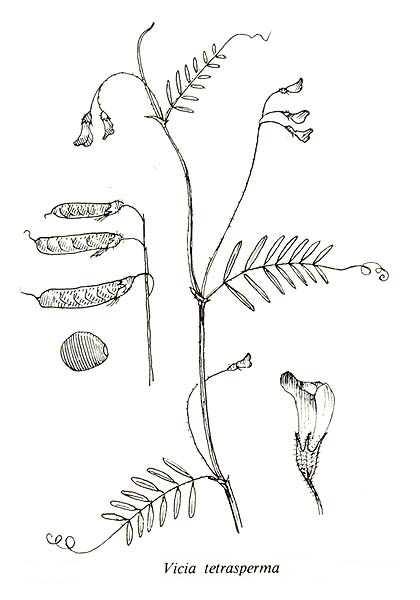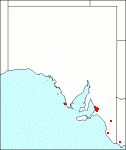Family: Fabaceae
Vicia tetrasperma
Citation:
Schreber, Spicil. Fl. Lips. 26 (1771).
Synonymy: Ervum tetraspermum L., Sp. Pl. 738 (1753).
Common name: Slender vetch.
Description:
Slender annual, subglabrous to appressed-pilose, stems procumbent to erect or climbing, 15-80 cm long, simple or branched, angular; leaves 1-4.5 cm long, 2-8-paired; leaflets linear or linear-oblong, 5-20 x 1-3 mm, acute or obtuse and mucronate, attenuate into a short petiolule, glabrous to appressed-pilose, tendrils mostly simple, filiform; stipules entire, semisagittate or hastate, the upper sometimes lanceolate, 2-3 mm long, subglabrous.
Flowers nodding to erect, 4-5 mm long, in axillary 1-3-flowered racemes on slender peduncles about as long as the leaves; bract lanceolate, to 0.5 mm long; calyx campanulate, pilose, 2-4 mm long, on a pilose pedicel a little shorter than the calyx, with an oblique lip; teeth subequal, narrowly triangular, scarcely shorter than the tube, the lower teeth longest; petals twice as long as the calyx, pale-blue, glabrous; standard broadly-ovate, reflexed, purple-veined; wings somewhat shorter than the standard, oblong, auriculate; keel shortest, with an upturned blue tip.
Pod shortly stipitate, linear-oblong, 8-15 x 2.5-5 mm, slightly constricted between the seeds, generally glabrescent, light-brown, 3-5-seeded; seed subglobular, c. 2 mm, brown, black-mottled; hilum short, ovate, one-quarter to one-fifth of the circumference, brown.

|
|
Image source: fig. 349 in J.P. Jessop and H.R. Toelken Ed. 1986. Flora of South Australia (4th edn).
|
Published illustration:
Ross-Craig (1954) Drawings Brit. Pl. 7:t. 59; Chrtková-Zertová (1979) Flora Iranica 140:t. 23, fig. 2.
|
|
Distribution:
|
S.Aust.: EP, SL, SE. all States except the N.T. an Eurasian and North African species of moist soils of thickets and fields, introduced to North and South America and New Zealand. Probably introduced as a contaminant of cereals.
|
Conservation status:
naturalised
Flowering time: Oct. — Jan.
|

SA Distribution Map based
on current data relating to
specimens held in the
State Herbarium of South Australia
|
Biology:
No text
Author:
Not yet available
|

